Iditarod
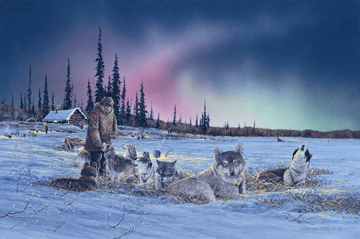
You can’t compare it to any other competitive
event in the world! A race over 1150 miles of the roughest, most
beautiful terrain Mother Nature has to offer. She throws jagged mountain
ranges, frozen rivers, dense forest, desolate tundra and miles of
windswept coast at the mushers and their dog teams. Add to that
temperatures far below zero, winds that can cause a complete loss of
visibility, the hazards of overflow, long hours of darkness and
treacherous climbs and side hills, and you have the Iditarod.
A race extraordinaire, a race
only possible in Alaska
From Anchorage, in south central
Alaska, to Nome on the western Bering Sea coast, each team of 12 to 16
dogs and their musher cover over 1150 miles in 10 to 17 days
It has been called the “Last Great
Race on Earth” and it has won worldwide acclaim and interest. German,
Spanish, British, Japanese and American film crews have covered the
event. Journalists from outdoor magazines, adventure magazines,
newspapers and wire services flock to Anchorage and Nome to record the
excitement. It’s not just a dog sled race, it’s a race in which unique
men and woman compete. Mushers enter from all walks of life. Fishermen,
lawyers, doctors, miners, artists, natives, Canadians, Swiss, French and
others; men and women each with their own story, each with their own
reasons for going the distance. It’s a race organized and run primarily
by volunteers, thousands of volunteers, men and women, students and
village residents. They man headquarters at Anchorage, Fairbanks,
Juneau, Nome and Wasilla. They fly volunteers, veterinarians, dog food
and supplies. They act as checkers, coordinators, and family supporters
of each musher.
An Event For All Alaska
Anchorage is the starting line — a city of over 250,000 people, street
lights, freeways and traffic. From there the field of dog teams which
grow in number each year, runs to Eagle River, Checkpoint # 1. After a
restart in the Matanuska Valley at Wasilla, the mushers leave the land
of highways and bustling activity and head out to the Yentna Station
Roadhouse and Skwentna and then up! Through Finger Lake, Rainy Pass,
over the Alaska Range and down the other side to the Kuskokwim River —
Rohn Roadhouse, Nikolai, McGrath, Ophir, Cripple, Iditarod and on to the
mighty Yukon — a river highway that takes the teams west through the
arctic tundra.
The race route is alternated every
other year, one year going north through Cripple, Ruby and Galena, the
next year south through Iditarod, Shageluk, Anvik.
Finally, they’re on the coast —
Unalakleet, Shaktoolik, Koyuk, Elim, Golovin, White Mountain and into
Nome where a hero’s welcome is the custom for musher number 1 or 61!
The Beginning
The first true Iditarod Trail Sled Dog Race to Nome
started in 1973, after two short races on part of the Iditarod Trail
in 1967 and 1969 ( there was no race in 1968 because of the lack of snow
). The idea of having a race over the Iditarod Trail was
conceived by the late Dorothy G. Page. In 1964, Page was chairman of the
Wasilla-Knik Centennial and was working on projects to celebrate
Alaska’s Centennial Year in 1967.
She was intrigued that dog teams
could travel over land that was not accessible by automobile. In the
early 1920's, settlers had come to Alaska following a gold strike. They
traveled by boat to the coastal towns of Seward and Knik and from there,
by land into the gold fields. The trail they used is today known as The
Iditarod Trail, one of the National Historic Trails as so designated by
the Congress of the United States. In the winter, their only means of
travel was by dog team.
Iditarod Today
The race has started in downtown Anchorage since 1983. The teams leave
the start line at the corner of 4th and “D” at two minute intervals,
starting at 10 a.m. There are usually over 65 teams starting and some
years even more.
Race Winners
| Year |
Musher |
Lead dog(s) |
Time (h:min:s) |
| 1973 |
 Dick Wilmarth
Dick Wilmarth |
Hotfoot |
20 days,
00:49:41 |
| 1974 |
 Carl Huntington
Carl Huntington |
Nugget |
20 days,
15:02:07 |
| 1975 |
 Emmitt Peters
Emmitt Peters |
Nugget & Digger |
14 days,
14:43:45 |
| 1976 |
 Gerald Riley
Gerald Riley |
Puppy & Sugar |
18 days,
22:58:17 |
| 1977 |
 Rick Swenson
Rick Swenson |
Andy & Old Buddy |
16 days,
16:27:13 |
| 1978 |
 Dick Mackey
Dick Mackey |
Skipper & Shrew |
14 days,
18:52:24 |
| 1979 |
 Rick Swenson
Rick Swenson |
Andy & Old Buddy |
15 days,
10:37:47 |
| 1980 |
 Joe May
Joe May |
Wilbur & Cora Gray |
14 days,
07:11:51 |
| 1981 |
 Rick Swenson
Rick Swenson |
Andy & Slick |
12 days,
08:45:02 |
| 1982 |
 Rick Swenson
Rick Swenson |
Andy |
16 days,
04:40:10 |
| 1983 |
 Rick Mackey
Rick Mackey |
Preacher & Jody |
12 days,
14:10:44 |
| 1984 |
 Dean Osmar
Dean Osmar |
Red & Bullet |
12 days,
15:07:33 |
| 1985 |
 Libby Riddles
Libby Riddles |
Axle & Dugan |
18 days,
00:20:17 |
| 1986 |
 Susan Butcher
Susan Butcher |
Granite & Mattie |
11 days,
15:06:00 |
| 1987 |
 Susan Butcher
Susan Butcher |
Granite & Mattie |
11 days,
02:05:13 |
| 1988 |
 Susan Butcher
Susan Butcher |
Granite & Tolstoi |
11 days,
11:41:40 |
| 1989 |
 Joe Runyan
Joe Runyan |
Rambo & Ferlin the
Husky |
11 days,
05:24:34 |
| 1990 |
 Susan Butcher
Susan Butcher |
Sluggo & Lightning |
11 days,
01:53:23 |
| 1991 |
 Rick Swenson
Rick Swenson |
Goose |
12 days,
16:34:39 |
| 1992 |
 Martin Buser
Martin Buser |
Tyrone & D2 |
10 days,
19:17:15 |
| 1993 |
 Jeff King
Jeff King |
Herbie & Kitty |
10 days,
15:38:15 |
| 1994 |
 Martin Buser
Martin Buser |
D2 & Dave |
10 days,
13:05:39 |
| 1995 |
 Doug Swingley
Doug Swingley |
Vic & Elmer |
10 days,
13:02:39 |
| 1996 |
 Jeff King
Jeff King |
Jake & Booster |
9 days,
05:43:13 |
| 1997 |
 Martin Buser
Martin Buser |
Blondie & Fearless |
9 days,
08:30:45 |
| 1998 |
 Jeff King
Jeff King |
Red & Jenna |
9 days,
05:52:26 |
| 1999 |
 Doug Swingley
Doug Swingley |
Stormy, Cola &
Elmer |
9 days,
14:31:07 |
| 2000 |
 Doug Swingley
Doug Swingley |
Stormy & Cola |
9 days,
00:58:06 |
| 2001 |
 Doug Swingley
Doug Swingley |
Stormy & Pepi |
9 days,
19:55:50 |
| 2002 |
 Martin Buser
Martin Buser |
Bronson |
8 days,
22:46:02 |
| 2003 |
 Robert Sørlie
Robert Sørlie |
Tipp |
9 days,
15:47:36 |
| 2004 |
 Mitch Seavey
Mitch Seavey |
Tread |
9 days,
12:20:22 |
|
2005 |
 Robert Sørlie
Robert Sørlie |
Sox & Blue |
9 days,
18:39:30 |
|
2006 |
 Jeff King
Jeff King |
Salem & Bronte |
9 days,
11:11:36 |
|
2007 |
 Lance Mackey
Lance Mackey |
Larry & Lippy |
9 days,
05:08:41 |
Seward Alaska - The Beginning
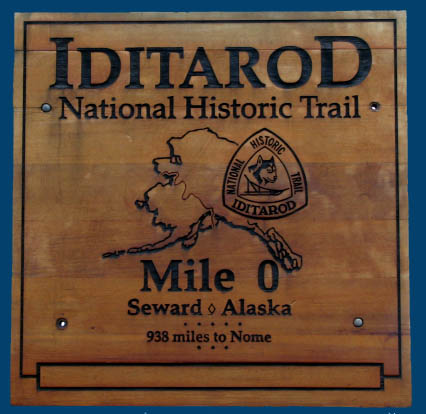 The
main route of the Iditarod trail extends 938 miles from Seward in the
south to Nome in the northwest, and was first surveyed by Walter Goodwin
in 1908, and then cleared and marked by the Alaska Road Commission in
1910 and 1911. The
main route of the Iditarod trail extends 938 miles from Seward in the
south to Nome in the northwest, and was first surveyed by Walter Goodwin
in 1908, and then cleared and marked by the Alaska Road Commission in
1910 and 1911.
The entire network of branching
paths covers a total of 2,450 miles. Except for the start in Anchorage,
the modern race follows parts of the historic trail.
Burl Arch - The Finish Line
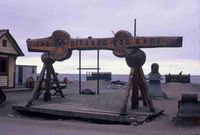 The
official finish line is the Red "Fox" Olson Trail Monument, more
commonly known as the "burled arch", in Nome. The original burled arch
lasted from 1975, until it was destroyed by dry rot and years of
inclement weather in 2001. The new arch is a spruce log with two
distinct burls, similar but not identical
to the old arch. While the old arch spelled out "End of the Iditarod Dog
Race", the new arch has an additional word: "End of the Iditarod Sled
Dog Race." The
official finish line is the Red "Fox" Olson Trail Monument, more
commonly known as the "burled arch", in Nome. The original burled arch
lasted from 1975, until it was destroyed by dry rot and years of
inclement weather in 2001. The new arch is a spruce log with two
distinct burls, similar but not identical
to the old arch. While the old arch spelled out "End of the Iditarod Dog
Race", the new arch has an additional word: "End of the Iditarod Sled
Dog Race."
A "Widow's Lamp" is lit and
remains hanging on the arch until the last competitor crosses the finish
line. The tradition is based on the kerosene lamp lit and hung outside a
roadhouse, when a musher carrying goods or
mail was en route.
On the way to the arch, each
musher passes down Front Street, past a saloon
once owned by Wyatt Earp, and down the
fenced-off 50-yard end stretch. The city's fire siren is sounded as each
musher crosses the finish line. While the winner of the first race in
1973 completed the competition in just over 20 days, preparation of the
trail in advance of the dog sled teams and
improvements in dog training have dropped
the winning time to under 10 days in every race since 1996.
Collectible Pins
|
Year |
Pin |
Pewter, Silver,
Gold, Pewter, Lapel, Buttons |
|
1967 |
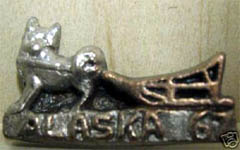 |
|
|
1975 |
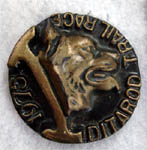 |
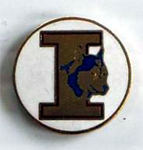 |
|
1981 |
|
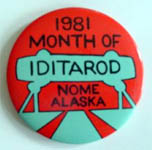
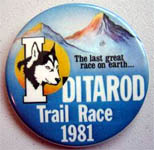
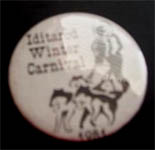 |
|
1982 |
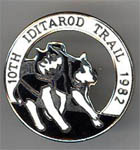 |
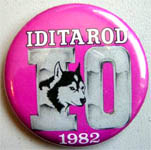 |
|
1983 |
 |
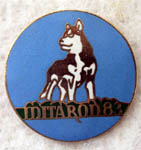
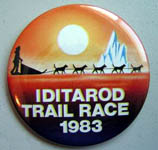
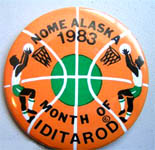 |
|
1984 |
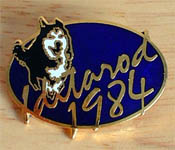 |
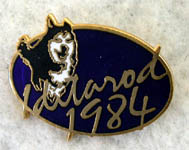
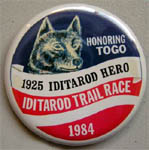 |
|
1985 |
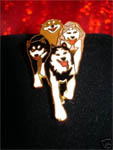 |
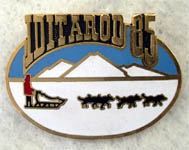
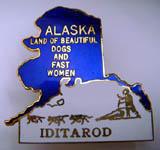
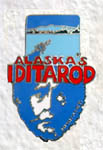
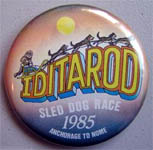
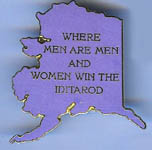 |
|
1986 |
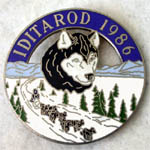 |
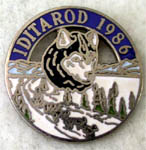
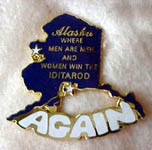 |
|
1987 |
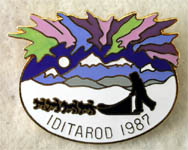 |
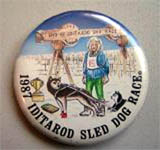
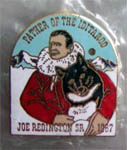
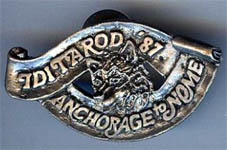 |
|
1988 |
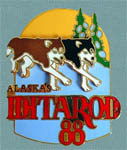 |
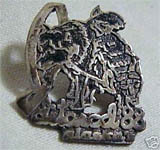
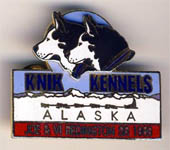
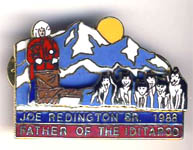
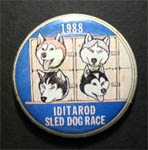 |
|
1989 |
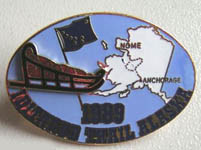 |
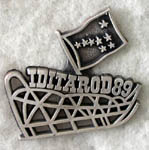
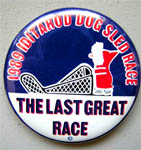
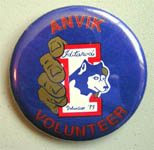 |
|
1990 |
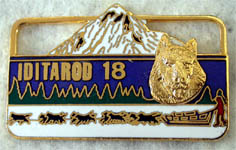 |
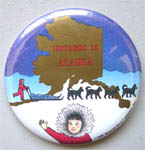 |
|
1991 |
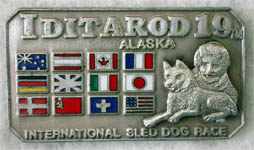 |
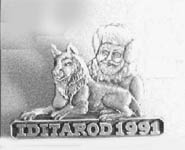
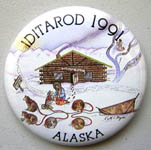 |
|
1992 |
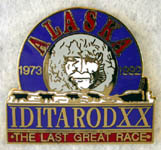 |
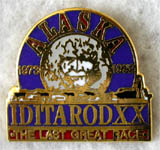
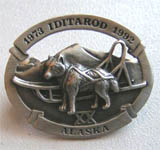 |
|
1993 |
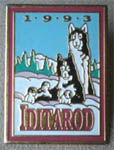 |
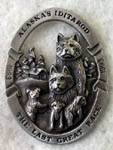
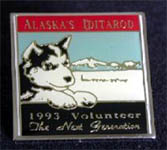
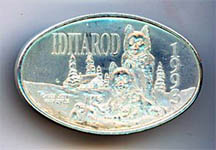
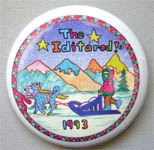 |
|
1994 |
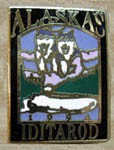 |
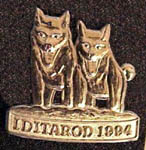


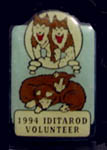
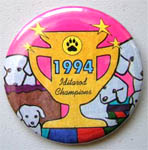 |
|
1995 |
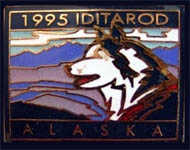 |
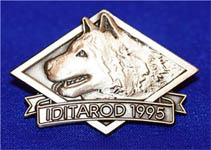
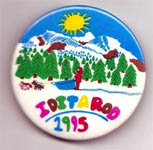 |
|
1996 |
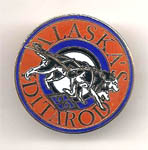 |
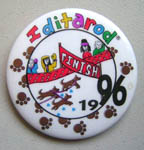 |
|
1997 |
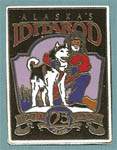 |
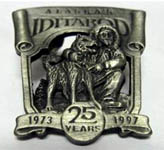 |
|
1998 |
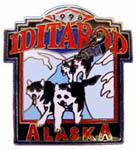 |
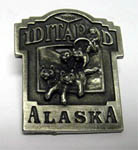
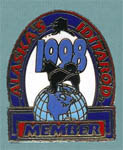 |
|
1999 |
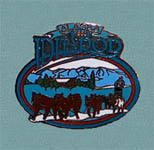 |
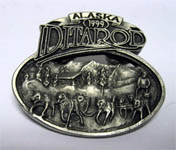 |
|
2000 |
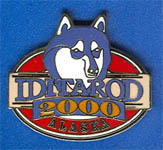 |
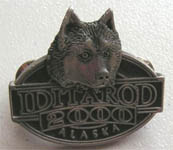 |
|
2001 |
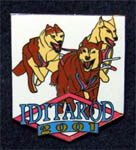 |
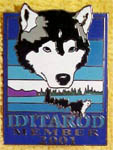 |
|
2002 |
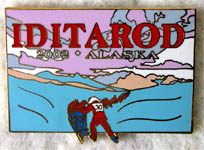 |
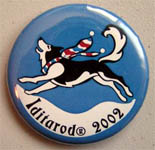 |
|
2003 |
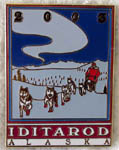 |
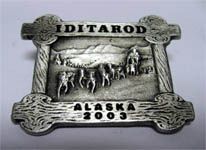 . . |
|
2004 |
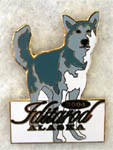 |
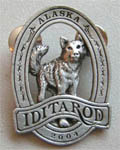 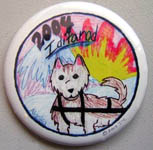 |
|
2005 |
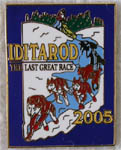 |
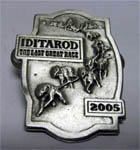 |
|
2006 |
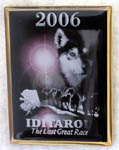 |
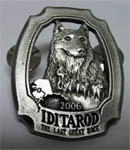 |
|
2007 |
 |
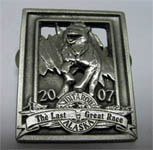
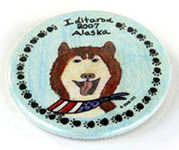 |
|
2008 |
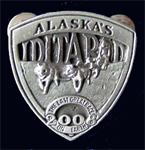 |
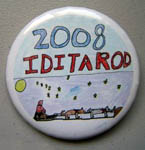
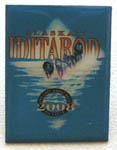 |
|
2009 |
|
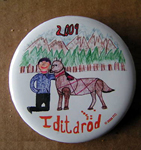 |
|
Other
Iditarod Pins |
|
1997 |
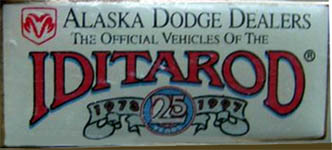 |
This is a Dodge
Dealer sponsor pin commemorating the Iditarod but
its year is unknown as of this posting. |
|
? |
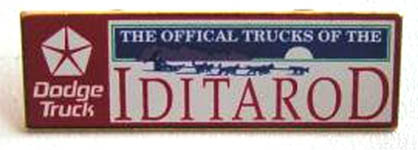 |
This is a Dodge
Dealer sponsor pin commemorating the Iditarod but
its year is unknown as of this posting. |
|
? |
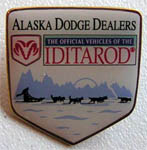 |
This is a Dodge
Dealer sponsor pin commemorating the Iditarod but
its year is unknown as of this posting. |
|
1980 |
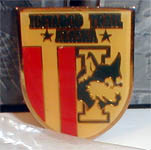 |
This
trail pin was released in the 80's but the exact date is uncertain at
this time. |
|
? |
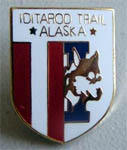 |
This
trail pin was released to celebrate the Iditarod but actual release date
is not know as of this posting. |
|
1988 |
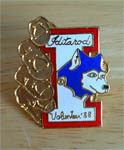 |
|
|
1990's |
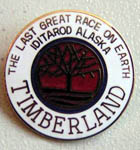 |
|
|
1989 |
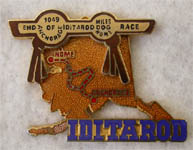 |
 |
|
Idita-Walk 2007 |
 |
To
get this pin, you had to complete the Idita-walk where you
register to walk
30 minutes a day for 35 days between February 3, 2007 to March
18, 2007
for a total of 1049 minutes same distance as the Iditarod. |
|
? |
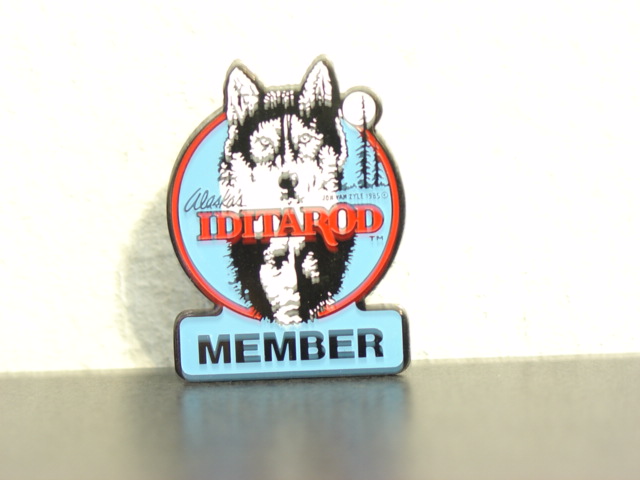 |
Member - 1" x 1 1/2" |
|
? |
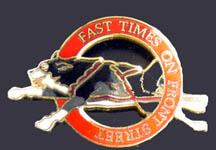 |
This Wm. Spear Designed pin
from Juneau, Alaska celebrates the Fast Times On Front Street
during the Iditarod |
|
? |
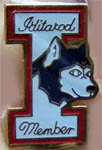 |
This pin is given to
Members of the Iditarod upon joining. |
| ? |
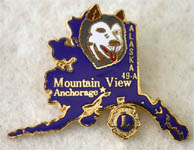 |
This stunning pin
features the map of Alaska and a sled dog.
|
|
? |
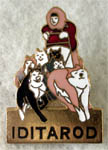 |
This pin celebrates the
Iditarod, but details of it's release and edition size are not
known at this time. |
| ? |
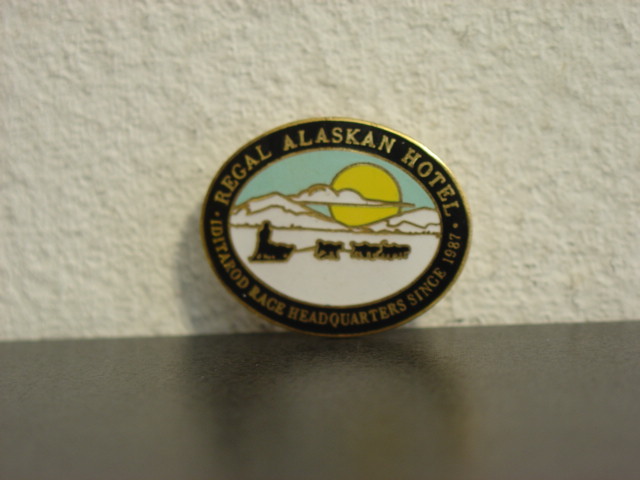 |
Regal Hotel - 1 7/8" x 1" |

|